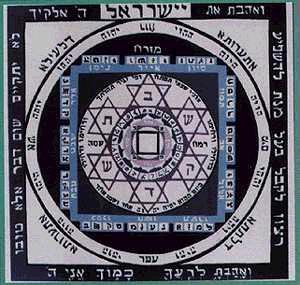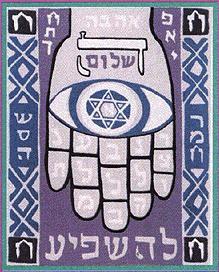|
The Function Of The Mandala Symbol In The Creative Process Of Information Design Ora N. Asael Silverstein The mandala symbol visualizing a circle or a sphere has the meaning of a center, wholeness and unity. Because of its fundamental meaning it is the most important symbol being used in both individual and collective human creativity. As such the study of the mandala design, is suitable for the undertaking of the design as a part of the visual thinking process, whilst its products are meant for the communication current within the "self" and between people. The presentation is based on mandala pictures from the work of C.G. Jung and from various cultures. Design and communication The evolution of information design stems from the need for design in all the media and communication tools being used today: printed media, electronic media and others. A good example is the given in Ismail Ipek's (1999) last paper. It presents considerations for computer window presentation. I give this example not only because it deals with Screen Design. In Ipek's paper, figure 1 gives a visual presentation by overlapping circles. The visual (Fig. 1) has the shape of a flower made out of 3 circles and in a way, it forms a mandala.  Other examples can be found. The use of twin circles in Silverstein & Tamir (1991) is one of these. On the twin circle symbol and other symbols there are several papers of research such as by Cochenour et al (1999) & Sayer et al (1999). The implication of the design process is to define and form an idea; the design is the outline of the main features of the idea as a scheme. It comes from the Latin word Signum meaning a mark, a sign. Actually "Information design" is a repetition of the same meaning twice. It does not strengthen its meaning and I could easily skip out the word information and refer in this paper, to "design". "Information Design" is an application domain, which enables human inter-personal and inter-cultural communication through visual illustration. Yet, it has existed from the very beginning of humanity, even though not as a definition. The Roots of Information Design Pictorial communication was used before the existence of writing. Sign and pictorial mode of communication was used by the American Indian culture. Today, we return to the picture through television, computers and other technologies. The linear writing, presented in the media, is combined with graphic texts, pictures, sounds and numbers. The role of the design process in human communication and fields of creativity are remarkable. The evolution of the media communication and the important tasks that icons have in our time, created the development of information design. There is also a remarkable development of its interactions, which are to be found in many fields such as education, research and application. The difference between the pictorial expression in the present and that of former times is not in its essence but in the intricacy of the techniques of the pictorial expressions in research and application. Communication was always used for human contact. Basically the design process comes out of the human need for sharing. We design in order to promote dialogue. On the creative process Design like every other form of creativity is the implementation of making something new and unique. We use the word imagination and subconscious while defining creativity. Since the process of creation is drawn from the very "self", it holds within it the being, essence, nature and quality of its maker. In the creative process the creator becomes aware of himself through his own creation and a work of art is a result of this process. Therefore, any creativity is the embodiment of the maker or of a group of people united in a process of togetherness. The examples, which I give to support this argument, are works, which present the use of the mandala symbol in different domains and web pages such as Loewenthal mandalas in the jewish mysticism, the kabbala, (Fig. 2) and the mandala paintings and web design of Kanter (1999). The reader will have to consider that some of these examples are expendable and changeable.  Symbols and Design Western culture developed linear reading and depends on it more than other cultures on our planet. But, now we are coming back to the picture and thus increase the power of visual thinking and the use of symbols. This process gives human imagery the position it should have in people's communications. A symbol has the power and capacity to give a whole scale of possibilities, in a given situation. Any description of the absolute must be limited and a symbol is capable of cutting through all the layers of our consciousness and provides full awareness of a phenomenon, a situation, and a concept. The best examples I can give for these symbols are the spiral and the circle. Symbols must also be visualized in three dimensions. Each circle is a part of a sphere. In order to understand the deepest meaning of design, we have to look for symbols. In this way we shall improve our capacity for a better understanding of our own past and the roots of our ancestors. By getting closer to the symbols shared by the various cultures of our planet we might behold what they sense. This enhances a return to our roots and a getting closer to ourselves. In eastern and western philosophy and psychology the roots of human both rational and creative thinking steam from nature. This is the reason why so many symbols are shared by all human beings. They are not forgotten but hidden in the collective subconscious C. J. Jung patients created mandala pictures (Fig. 3). Jung himself made mandala paintings and in his writings (1964) he gives many examples of patients works and of his own. We know that it is within each of us, within our cultures that we gain the insight to know our real identity. All the important symbols are concealed in the archetypes. Their meanings are important for our understanding and creativity. These symbols are the essence of our human microcosmic being. The celestial bodies form and macrocosmic space movements make the structure of nature around us and become the very sources for shaping human beings' imagery and symbol formations. These symbols are found in jewelry, costumes architecture and every other form of human design. . The people of Europe, India and Iran all used the same word for knowledge. In Latin "Video" which means I see has the meaning of I understand. The Greeks used the word "Idea" and in Sanskrit it is "Videa". In English the word is "Wise" and in German "Wissen". In the Jewish kabbala (Halevi, S. 1984) "Eye sight" is the stipulation for understanding. It is through language that we find confirmation for the determination that shaping of ideas has been started in our world from the very beginning Mandala By A Woman Patient  Arnheim's theory on visual thinking is given in one of the "New Essays on the Psychology of Art: A plea for Visual Thinking" (1986). This is only one essay and one book of the many books he wrote, in which he shows that the thinking process is operated by imagery. There is enough evidence in his scholarly writings to corroborate his theory that design is part of the creative process, which is started in the human mind by rational thinking, and by intuition. The thinking process has to do with perception but also with hidden visual messages. The theories on art and literature show that the artist is a medium of his own subconscious. More evidence can be found in Arnheim's "Art and Visual Perception" (1974) and in "To the Rescue of Art: Twenty-six Essays" (1992) as well as in C.G. Jung's: "Man and His Symbols" (1964). On Symbolism and Creativity There is substantial evidence and literature, showing that human imagery is essential in the process of concept formation (Arnheim, 1974, 1986, 1992). It is agreed upon that visual thinking has a part in the process of every verbal formation and that a verbal – visual process occurs in our mind while performing intellectual activities. It is in the symbol domain that we should seek for the very beginning of our creativity. I think that using only one example provides the best demonstration of an idea. This is why, in this paper, I use only the mandala symbol for my discussion on the concept of Design. The Mandala Symbol The mandala is a metaphor of wholeness, unity, center and self. It is a very powerful symbol; the most powerful resource in human creativity and that is what makes it a very good example. The sun and the moon, the fertilized egg and the atoms, the flowers and drops of water, all these gave birth to the symbol of the mandala (Fig. 4). According to many writers and travelers' manuels and visuals, the symbol of the mandala, the circle, represent the universe. Both the macrocosmos around us and the microcosmos which is the world within ourselves. Sun – Mandala. Rajasthan  According to the psychology of C.G. Jung, the mandala is the embodiment of the self (Hjeller Ziegler, 1992). The word mandala comes from the Sanskrit language and means a circle. Yet, in order to understand it thoroughly and correctly we will have to add "holy" meaning a holy circle or a healing circle, which is symbolized by the circle and the sphere. C.G. Jung developed his theory of the collective subconscious and the archetype, after years of traveling, in which he became familiar with the different cultures on the planet earth. According to his theory, all human beings share the same basic unconscious, common to all cultures and emerging from the same impression of the world. And, indeed, Literature, study, travel and experience, show that Jewish Kabbala (Halevi, 1984), Zen (C.G. Jung, 1964), Hinduism (Mookorjee, 1997), and Budhism (Shearer, 1992) have the same symbols going back to the same sources. Fig. 5 is a very interesting example. It is another work of Loenthal. The "chamsa", meaning 5, is a sign of luck. Here it is symbolized by a hand with 5 fingers. This hand is a hand for peace and love as wreeten above the mandala located in the eye. The hebrew letter ä is the mark for God. The "Magen David" Shield of David is to be found in various cultures. The reader will find enough evidence for the expressed ideas in "Man and His Symbols" by C.G. Jung (1964). In the paragraph on eternal symbols page 98, he wrote: "The unconscious mind of modern man preserves the symbol making capacity that once found expression in the beliefs and rituals of the primitive." I will add one criterion from the many examples found in the same book. I took the symbol of the circle: p, 268; "In the Zen sect, the circle represents enlightenment. It symbolizes human perfection". Use of the Mandala Symbol in the Process of Design According to Arnheim, children draw circles at a very early age, because the circle is the simplest shape "available in the pictorial medium" (1974, p. 176) and it is "centrally symmetrical in all directions". He argues with the theories of Freud and Jung and does not think that this drawing of a circle has to do with round objects in the surroundings: "the circle does not stand for roundness but for the more general quality of thingness" (1974 Fig. 120, p. 177). It is an interesting argument and in any case, again, drawing a circle at the very beginning of human visual creativity is a fact everybody agrees upon. The use of the circle is found in every culture, in architecture, early picture writing, dancing and many other modes of creativity and design. Chamsa  In the Old World, circles were built as gathering places for ceremonial purposes. There are over 900 stone circles all over the world, of which the most impressive are Newgrang and Stonehendge (Atkinson, 1987. Petterson, 1998). In the Holy Land there are a few ceremonial circles, one of which was studied by the writer this year. It is called Rujm Hiri (Silverstein, to be published in 2000). Dancing is one of the most important ways of expression in human creativity. Mevlana and the whirling Dervishes in Konya, Turkey are the outstanding example of circular dancing. The reader can easily identify evidence of manadala symbolism in the works of design in his familiar surroundings, as well as all over the planet. Attached list 1: Works Designed According to the Mandala Symbol. Discussion In this article I have taken an example of one concept so as to facilitate the perception of the influence of spatial form on personal and collective thinking and to see its expression in human philosophy, psychology and its application, that is to say, in design. Using the mandala symbol in a process of awareness has enchanted me since the mandala is truthfully world embracing. There is nothing like it to be used as an example in order to materialize the ideas expressed in this article (Fig. 6). The example of the mandala leads towards an insight showing that the process of thinking with pictures operates in the human cognition and enables us the design process. In addition, the design process is actually based on configuration materials preserved in the human culture and thinking processes from the beginning of mankind. These are preserved in the collective subconscious of each and every one of us. Emerging in the process of design personal expression joins the archetypal heritage out of the personal subconscious by an imagery process in the special creative apparel of every entity. This is the source of the final creative expression, as it emerges in the process of design. Tibetan World Wheel  List 1: Works Based on the Mandala The structure of the modern Cathedral of the city of Brasilia, (C.G. Jung, 1964, p. 231) The Ankor Wat Buddhist temple in Cambodia. Paris – L'Etoile ,(C.G. Jung, 1964, p. 270). Renaissance religious art, (C.G. Jung, 1964, p. 274). Alchemical concept, (C.G. Jung, 1964, p. 280). 16th century German art, (C.G. Jung, 1964, p. 284). Mid – 20th century art, (C.G. Jung, 1964, p. 321). Kabbala works, (Halevi, 1984, p. 6, 10). Mandala symbolism (1973) C.G. Jung Pictures 1-24, Fig. 1-54 Sun-disc Mandala, Rajasthan, (Mookerjee & Khaanna, 1977, pp. 42, 73). Macrocosm , Microcosm & Mandala, (Shearer, A. 1992, pp. 84, 85). Reference Arnheim, R. (1974) Art and Visual Perception. University of California press. Arnheim, R. (1986) New Essay on the Psychology of Art. University of California Press. Arnheim, R. (1992) To the Rescue of Art : Twenty Six Essays. University of California press. Atkinson, R.J.C. (1987). Stonehenge and Neighboring Monuments. English heritage Cochenour, J.J. Rezabek, L.L. Westhoff, G. (1999) Interpreting Symbols: The Spread of Visual Meaning, in: Griffin, R.E. Gibbs, W.G., Wiegmann, B. (Eds.), Visual Literacy in an Information Age. Readings, International Visual Literacy Association, p. 70 Halevi, Z. b S. (1984) The Work Of The Kabbalist. Samuel Weiser, inc. New York Beach, Maine. Hjelle, L.A. Ziegler, D.J. (1992) Personality Theories McGraw-Hill, pp 172-176 Ipek, I. (1999). Considerations for CBI Screen Design With Respect to Field Dependence and Computer Window Presentation Type. p. 160 in: Griffin, R.E. Gibbs, W.J. Wegmann, B. (Eds.) Visual Literacy in an Informaiton Age, Selected Readings of theInternational Visual Literacy Association . Jung, C.G. (1964). Man and his Symbols". Laurel. Jung, C.G. (1973). Mandala Symbolism, Princeton University Press. Klinck,N.A. (Ed.) (1993). Are We Ready For Year 2001? A Survey of Student Perceptions. Tech Trends. The Magazine of The Association For Educational Communications and Technology. Sept. 1993, Vol 38 No. 4, p. 28 Kanter Movchine Anika(1999) http://www.haderech.org/mandala Kanter Movchine, A.K. About Mandala. Kibbutz Shomrat, D.N. Ashrat, 25218, Israel Mookerjee, A. Khanna, M. (1997) The Tantric Way, Thames & Hudson Loewenthal,A.(1999) http://www.freeyellow.com/members5/kabbala Pettersson, R. (1998) Circles, Triangles and Squares: Sacred Symbols in the Mayan Culture. In: Griffin, R.E. Schiffman, C.B Gibbs, W.G. (Eds.) Connecting with the community: Exploring Resources for Visual Learning & Expression. Selected readings of the International Visual Literacy Association. P. 46. Silverstein Asael, O.N. Tamir, P. (1991) The Perception of Biological Concepts Through Story Animated Movies. In Baca, J.C. Beauchamps, D.G. Braden, R.A. (Eds.) Communictions: Bridging Across Countries. Readings, The international Visual Literacy Association, pp. 127-139 Silverstein Asael, O.N. (1996). Science Picture Language. In Velders, T. (Ed.) Multimedia Education in Praxis. Selected readings. The 4th International Research Symposium on Visual Verbal Literacy, International Visual Literacy Association. Silverstein Asael, O.N. (1997). Imagery, Concept Formation & Creativity – From Past to Future. In Griffin, R.E. Hunter, J.M. Schiffman, C.B. Gibbs, W.J. Vision Quest: Journeys Toward Visual Literacy. Selected readings of IVLA pp. 305-312. Silverstein Asael, O.N. (1999) Postmodern Verbo-visual Women's Creativity. In Griffin, R.E. Gibbs, W.J. Wiegmann, B. (Eds.). Visual Literacy in an Information Age. Selected Readings of The International Visual Literacy Association Sayre, R. Dunkerley, S. Horton, D. Fullwodd, M.R. (1999). Gestalt, Context, Ambiguity and Archetypal Meaning in Photographic Education.(1999). In Griffin, R.E. Gibbs, W.J. Wiemann, B. (Eds.) Visual Literacy In An Information Age pp. 283, 284, 286, 287 Shearer, A. (1992). Buddha, Thames and Hudson Young, N.J. (1992). Signs From the Ancestors. University Of New Mexico Press, pp. 77, 118. |